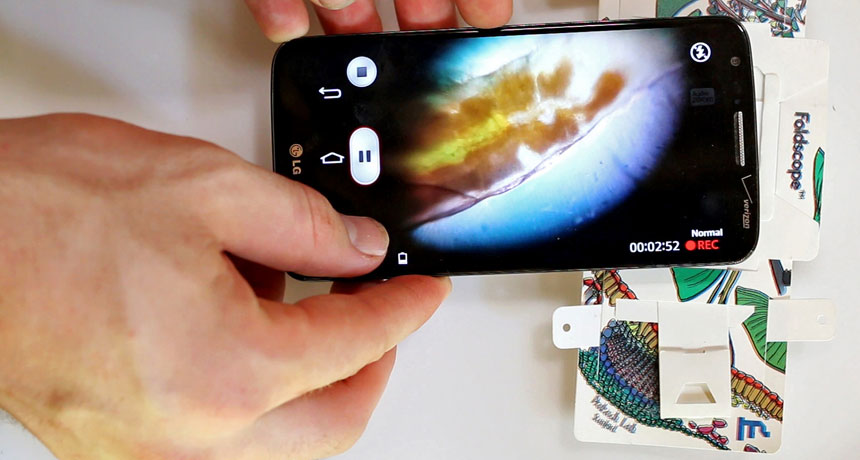A paper microscope magnifies on the go
A new paper microscope could bring small worlds to light in the classroom and beyond

The foldscope — a microscope made from paper — can magnify objects up to 2,000 times.
Aaron Pomerantz/The Next Gen Scientist/Flickr/ (CC BY 2.0)
NASHVILLE, Tenn. — Classroom microscopes bring the small to life. Recently, inventors developed a microscope made mostly from paper. It’s light, cheap and surprisingly tough. Called a “foldscope,” it could allow anyone to magnify on the go. Its designers promise to make these devices cheap enough that nearly every student could afford one. But not yet. So far, only a few thousand have been manufactured. However, if you are very determined, you can build your own.
A good classroom microscope — one with an adjustable platform for slides and a few levels of magnification — can run from $80 to more than $200. With price tags like that, it can be tough for cash-strapped schools to give every student access to one. And, of course, a large in-class microscope is too heavy for a kid to take home, too fragile to tote to a local stream and too expensive for a teacher to easily replace if it breaks.
Enter Manu Prakash and the foldscope. He’s an inventor at Stanford University California. Previously, Prakash designed a crank-operated chemistry set and a scanner for mouth cancers that attaches to a smartphone. Then, two years ago, he and his colleagues published an article describing the foldscope. It’s an origami-based device in which a single sheet of paper is folded to create the structure of the microscope. Like a conventional microscope, it has a place for slides, a lens and a light. The big difference? This scope costs only $0.58. But don’t let its tiny price tag fool you. This tool can magnify objects up to 2,000 times.
The entire microscope is embedded within a single piece of coated paper. That coating helps make it water-resistant. It can be easily punched out and folded (with guidance from a video on YouTube). Once this simple assembly is complete, users can insert regular microscope slides into it, then bend the foldscope slightly to bring the objects into focus. Images can be projected up onto a wall by shining a flashlight behind the scope. Users also can photograph specimens with a smartphone.
FOLD IT! In this TED talk, Manu Prakash shows off the power — and toughness — of a microscope made of paper. TED |
In a TED talk — a popular video series that showcases new or popular ideas — Prakash demonstrated the microscope’s toughness four years ago. He showed a foldscope being dropped from a three-story building. He jumped up and down on another. He even told of accidentally running one through the laundry.
Prakash originally designed the device to help bring healthcare to relatively poor areas of the world. Many countries do not have enough conventional microscopes to quickly and easily diagnose diseases such as malaria. With the cheap, tough foldscope, Prakash planned to bring more microscopes — and faster diagnoses — to the people who need them.
But the foldscope isn’t limited to healthcare. Prakash also thinks these devices might offer a great way to get kids interested in science, technology, engineering and math. And he’s not alone. Judith Bazler is a science education researcher at Monmouth University in West Long Branch, N.J. She saw Prakash’s TED talk and immediately recognized an opportunity. “I had a vision in my head of kids taking home a foldscope,” she says. “Why couldn’t they? They can’t break it!”
Folding a microscope into a lesson plan
Bazler showed the TED talk to a student, Carleigh Engstrom. Engstrom, now teaching at Ilan High School in Ocean, N.J., also got excited about the foldscope. Right away, she set out to make lesson plans to incorporate the paper microscopes into field trips outside the classroom. Right now, she has lesson plans to help students categorize types and sizes of sand grains, and to identify microbes in a water sample. The two showed off their lesson plans here at the National Science Teachers Association meeting on April 1.
Science teachers got to play with the foldscopes. They magnified sand, pollen and other materials.
It would be great to see them in a classroom setting, said Nic Watkins, a sixth grade teacher at Union Elementary in Dayton, Ohio. “It’s better than what we have now. And the fact that they are [roughly] $0.50 means we could easily provide one of these for each kid.”
Working with the foldscope takes a bit of practice at first. To focus them, they must be bent slightly. And getting that focus right can be hard if a student — or teacher — is wearing glasses, notes Donna Casanova. She’s supervises science programs for Providence Public Schools in Rhode Island. In some ways, she finds, bending the microscope for focus means “it’s hard to take pictures without an extra pair of hands.”
The foldscope project is currently in beta testing — meaning a few thousand people have them and can use them, but the microscopes are not yet being widely produced. The first 10,000 were made available to people who submitted an application. Prakash and his lab now are in the process of creating a company to sell them widely. In the meantime, their lab has posted instructions for free so that people can make their own foldscopes. Are you game?
Follow Eureka! Lab on Twitter
Power Words
(for more about Power Words, click here)
magnify To increase in apparent size or number of something.
microscope An instrument used to view objects, like bacteria, or the single cells of plants or animals, that are too small to be visible to the unaided eye.
microscopic An adjective for things too small to be seen by the unaided eye. It takes a microscope to view such tiny objects, such as bacteria or other one-celled organisms.